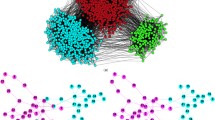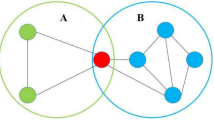Abstract
There has been considerable interest in designing algorithms for detecting community structure in real-world complex networks. A majority of these algorithms assume that communities are disjoint, placing each vertex in only one cluster. However, in nature, it is a matter of common experience that communities often overlap and members often play multiple roles in a network topology. To further investigate these properties of overlapping communities and heterogeneity within the network topology, a new method is proposed to divide networks into separate communities by spreading outward from each local important element and extracting its neighbors within the same group in each spreading operation. When compared with the state of the art, our new algorithm can not only classify different types of nodes at a more fine-grained scale successfully but also detect community structure more effectively. We also evaluate our algorithm using the standard data sets. Our results show that it performed well not only in the efficiency of algorithm, but also with a higher accuracy of partition results.
Similar content being viewed by others
References
Shen H W, Cheng X Q, Chen H Q, Liu Y. Information bottleneck based community detection in network. Chinese Journal of Computers, 2008, 31(4): 677–686
Kernigan B. An efficient heuristic procedure for partitioning graphs. Bell System Technical Journal, 1970
Eckmann J P, Moses E. Curvature of co-links uncovers hidden thematic layers in the World Wide Web. In: Proceedings of the National Academy of Sciences of the United States of America, 2002, 99(9): 5825–5829
Newman M E J, Girvan M. Finding and evaluating community structure in networks. Physical Review E: Statistical, Nonlinear, and Soft Matter Physics, 2004, 69(2): 026113
Girvan M, Newman M E J. Community structure in social and biological networks. Natl. Acad. Sci., 2002, 99(12): 7821–7826
Macqueen J B. Some methods of classification and analysis of multivariate observations. In: Proceeding of 5th Berkeley Symp on Mathematical Statistics and Probability. 1967: 281–297
Pothen A, Simon H D, Liou K P. Partitioning sparse matrices with eigenvectors of graphs. SIAM J. Matrix Anal. Appl., 1990, 11(3): 430–452
Brandes U. A faster algorithm for betweenness centrality. Journal of Mathematical Sociology, 2001, 25: 163–177
Fortunato S, Latora V, Marchiori M. Method to find community structures based on information centrality. Physical Review E: Statistical, Nonlinear, and Soft Matter Physics, 2004, 70(5): 056104
Radicchi F, Castellano C, Cecconi F, Loreto V, Parisi D. Defining and identifying communities in networks. In: Proceedings of the National Academy of Sciences of the United States of America, 2004, 101(9): 2658–2663
Wu F, Huberman B. Finding communities in linear time: a physics approach. The European Physical Journal B, 2004, 38(2):331–338
Zhou H J, Lipowsky R. Network brownian motion: A new method to measure vertex-vertex proximity and to identify communities and subcommunities. Lecture Notes in Computer Science, 2004, 3038: 1062–1069
Bagrow J P, Rozenfeld H D, Bollt E M, et al.. How famous is a scientist? -famous to those who know us. cond-mat/0404515, Euro phys. Lett, 2004, 67(4): 511–516
Capocci A, Servedio V D P, Caldarelli G, Colaiori F. Communities detection in large networks. Lecture Notes in Computer Science, 2004, 3243: 181–187
Reichardt J, Bornholdt S. Detecting fuzzy community structures in complex networks with a potts model. Physical Review Letters, 2004, 93(21): 218–224
Guimera R, Sales-Pardo M, Amaral L A N. Modularity from fluctuations in random graphs and complex networks. Physical Review E, 2004, 70(2): 025101(R)
Newman M E J. Fast algorithm for detecting community structure in networks. Physical Review E: Statistical, Nonlinear, and Soft Matter Physics, 2004, 69(6): 66–133
Duch J, Arenas A. Community detection in complex networks using extreme optimization. Physical Review E, 2005, 72: 027104
Donetti L, Munoz M A. Detecting Network Communities: a new systematic and efficient algorithm. Journal of Statistical Mechanics, 2004: P10012
Donetti L, Munoz M A. Improved spectral algorithm for the detection of network communities. In: Proceedings of the 8th International Conference on Modeling Cooperative Behavior in the Social Sciences. New York: American Institute of Physics, 2005, 779: 104–107
Palla G, Derenyi I, Farkas I, Vicsek T. Uncovering the overlapping community structure of complex networks in nature and society. Nature, 2005, 435(7043): 814–818
Tyler J R, Wilkinson D, Huberman B. E-Mail as spectroscopy: automated discovery of community structure within organizations. Information Society, 2005, 21(2): 143–153
Son S W. Random field ising model and community structure in complex networks. The European Physical Journal B, 2006, 50: 431
Boccaletti S. Detection of complex networks modularity by dynamical clustering. Phys Rev E Stat Nonlin Soft Matter Phys, 2007, 75(4 Pt 2): 045102
Han Y N, Li D Y. A novel measurement of structure properties in complex networks. Lecture Notes of the Institute for Computer Sciences, Social Informatics and Telecommunications Engineering, 2009, (5): 1292–1297
He N, Li D Y. Evaluate nodes importance in the network based on data field theory. In: Proceedings of the 2007 International Conference on Convergence Information Technology. 2007, 1225–1234
Amaral L A N, Ottino J. Complex networks. European Physical Journal B, 2004, 38(2): 147–162
Newman M E J. Assortative mixing in networks. Physical Review Letters, 2002, 89(20): 208701
V Colizza, A Flammini, M A Serrano, A Vespignani. Detecting rich-club ordering in complex networks. Nature Physics 2, 2006: 110–115
Barabási A L, Albert R. Emergence of scaling in random networks. Science, 1999, 286(5439): 509–512
Amaral L A N, Scala A, Barthelemy M, Stanley H E. Classes of small-world networks. In: Proceedings of the National Academy of Sciences of the United States of America, 2000, 97(21): 11149–11152
Gregory S. An algorithm to find overlapping community structure in networks. In: Proceedings of the 11th European Conference on Principles and Practice of Knowledge Discovery in Databases. 2007, (4702): 91–102
Du N, Wang B, Wu B. Overlapping community structure detection in networks. In: Proceedings of the 17th ACM Conference on information and Knowledge Management. 2008, 1371–1372
Zhang S H, Wang R S, Zhang X S. Identification of overlapping community structure in complex networks using fuzzy c-means clustering. Physica A: Statistical Mechanics and its Applications. 2006, 374(1): 483–490
Clauset A, Newman M E J, Moore C. Finding community structure in very large networks. Physical Review E: Statistical, Nonlinear, and Soft Matter Physics, 2004, 70(6): 066111
Girvan M, Newman M E J. Community structure in social and biological networks. In: Proceedings of the National Academy of Sciences of the United States of America, 2002, 99(12): 7821–7826
Leskovec J, Lang K J, Dasgupta A. Statistical properties of community structure in large social and information networks. In: Proceedings of the 17th international conference on World Wide Web. 2008, 695–704
Ulrik B, Daniel D, Marco G, Robert G. On finding graph clustering with maximum modularity. In: Proceedings of the 33rd International Workshop on Graph-Theoretic Concepts in Computer Science. 2007, (4769): 121–132
Rumi G, Kristina L. Community detection using a measure of global influence. In: Proceedings of the 2nd SNA-KDD Workshop’ 08. Las Vegas, Nevada, USA. 2008, 0805.4606
Niu Y Q, Hu B Q, Zhang W, Wang M. Detecting the community structure in complex networks based on quantum mechanics. Physical A: Statistical mechanics and its applications, 2008, 387(24): 6215–6224
Author information
Authors and Affiliations
Corresponding author
Rights and permissions
About this article
Cite this article
Han, Y., Li, D. & Wang, T. Identifying different community members in complex networks based on topology potential. Front. Comput. Sci. China 5, 87–99 (2011). https://doi.org/10.1007/s11704-010-0071-x
Received:
Accepted:
Published:
Issue Date:
DOI: https://doi.org/10.1007/s11704-010-0071-x




